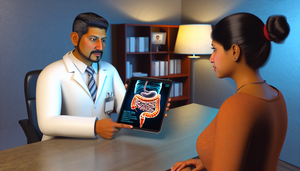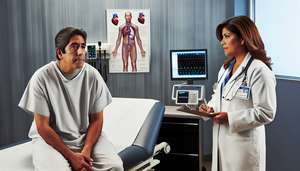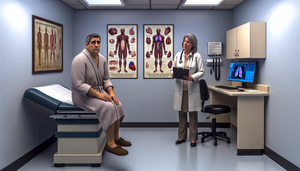
Irritable Bowel Syndrome vs. Inflammatory Bowel Disease: Distinguishing Functional Disorders from Inflammation in Chronic Abdominal Pain
Discover how to differentiate between irritable bowel syndrome and inflammatory bowel disease for effective treatment.
Read more
Gallstones and Acute Pancreatitis: Clinical Guidance and Imaging Tests for Acute Abdominal Pain
Explore the relationship between gallstones and acute pancreatitis, highlighting effective diagnosis and management.
Read more
Gastroesophageal Reflux vs. Peptic Ulcer: Key Signs for Differential Diagnosis of Epigastric Pain and Endoscopy Considerations
Discover how to differentiate between gastroesophageal reflux and peptic ulcer for effective treatment.
Read more
Pulmonary Hypertension vs. Heart Failure: Key Diagnostic Elements and the Role of Doppler Echocardiogram in Assessing Pulmonary Arterial Pressure and Fatigue
Discover how to differentiate between pulmonary hypertension and heart failure for effective treatment.
Read more
Peripheral Arterial Disease vs. Diabetic Neuropathy: Managing Lower Limb Pain and Claudication with Ankle-Brachial Index Assessment
Differentiating between peripheral arterial disease and diabetic neuropathy is crucial for managing lower limb pain in diabetic patients.
Read more
Arrhythmic Syncope vs. Vasovagal Syncope: Identifying Dizziness Triggers Through Cardiac Monitoring
Discover how to differentiate between vasovagal syncope and arrhythmia for effective treatment.
Read more
Heart Failure vs. COPD: Identifying the Underlying Cause of Chronic Dyspnea with Imaging Tests and BNP
Discover how to differentiate between heart failure and COPD in patients with chronic dyspnea.
Read more
Atrial Fibrillation vs. Supraventricular Tachycardia: Diagnostic Strategies for Common Cardiac Arrhythmias and ECG Interpretation
Explore advanced strategies for the effective diagnosis and management of AF and SVT, enhancing patient outcomes.
Read more
Hypertensive Emergency vs. Hypertensive Urgency: Clinical Management Priorities for Extreme Blood Pressure and Organ Damage
Discover how to effectively distinguish and manage hypertensive emergencies and urgencies to prevent serious complications.
Read more
Myocardial Infarction vs. Aortic Dissection: Critical Decisions in Acute Chest Pain Management and Blood Pressure Control
Discover how to effectively differentiate and manage myocardial infarction and aortic dissection.
Read more
Stable Angina vs. Gastroesophageal Reflux: Key Points for Diagnosing Chest Pain with Stress Tests and Endoscopy
Discover how to differentiate between stable angina and gastroesophageal reflux for an accurate diagnosis of chest pain.
Read more
COVID-19 vs. Influenza: Practical Recommendations for Differential Diagnosis of Fever and Fatigue Using PCR Testing
Discover how to effectively differentiate between COVID-19 and influenza using symptoms, imaging, and molecular tests.
Read more
Sarcoidosis vs. Idiopathic Pulmonary Fibrosis: A Clinical Evaluation Guide for Progressive Dyspnea and Pulmonary Function Tests
Discover how to differentiate and manage sarcoidosis and idiopathic pulmonary fibrosis in clinical practice.
Read more
Pulmonary Embolism vs. Pneumonia: Guidelines for Differentiating Causes of Dyspnea and Chest Pain
Discover how to differentiate between pulmonary embolism and pneumonia for an accurate diagnosis of dyspnea and chest pain.
Read more
Acute Bronchitis vs. Whooping Cough: Diagnostic Tips for Managing Persistent Cough and Laboratory Tests
Differentiating between acute bronchitis and whooping cough is crucial for effective antibiotic management.
Read more
Bacterial Pneumonia vs. Atypical Pneumonia: Key Clinical Diagnosis Points and Chest X-Ray Insights
The precise distinction between bacterial and atypical pneumonia is crucial for effective antibiotic treatment.
Read more
Viral Respiratory Infection vs. Allergic Rhinitis: Differentiating Nasal Etiology and Managing Nasal Congestion
Learn to differentiate between viral infections and allergic rhinitis for effective treatment.
Read more
Asthma vs. COPD: Key Insights for Effective Respiratory Diagnosis in Primary Care
Discover how spirometry and biomarkers enhance the differential diagnosis between asthma and COPD.
Read more
Cataract Treatment: Phacoemulsification Surgery and Intraocular Lens Implant for Optimal Visual Recovery
Phacoemulsification with intraocular lens implantation provides rapid and effective visual recovery.
Read more
Endometriosis Treatment: Hormonal Medications, Oral Contraceptives, and Surgical Options for Pain Management
Explore personalized treatments for endometriosis, ranging from hormonal medications to laparoscopic surgery.
Read more